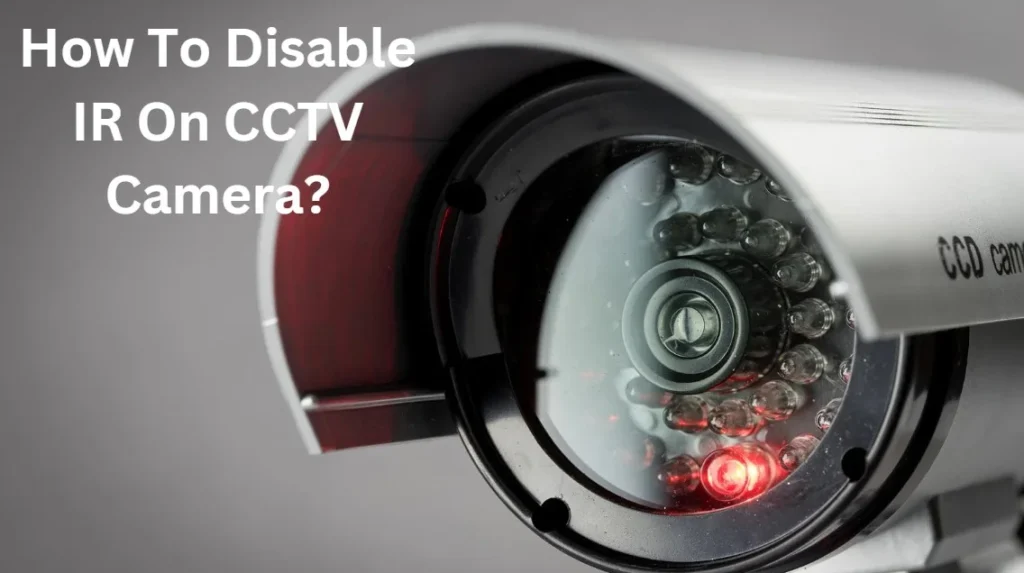In today’s security landscape, CCTV cameras play a vital role in safeguarding our homes and businesses. One of their key features is the Infrared (IR) night vision capability, which allows for clear imaging in low-light conditions.
However, there are situations where you might need to disable this feature. Whether you’re dealing with glare issues, maintaining your camera, or simply using ample ambient lighting, knowing how to disable IR on CCTV cameras can enhance your surveillance experience.
In this guide, walk you through the steps to effectively turn off the IR functionality, ensuring your CCTV system operates optimally for your specific needs.
Let’s dive into the process and make the most of your security setup!
Understanding Infrared (IR) Technology in CCTV Cameras
IR technology involves light that’s outside the visible spectrum, allowing cameras to record in low or no light.
IR LEDs surrounding a camera lens emit infrared light, illuminating areas that would otherwise be too dark for clear footage.
This “night vision” feature, found in many modern CCTV cameras, is invaluable in security setups.
Reasons For Disabling IR On CCTV Cameras
While IR has clear advantages, there are legitimate reasons some users may want to turn it off:
1. Privacy concerns in specific locations where IR might interfere with visibility.
2. Glare or reflection issues in certain environments, like through windows or on reflective surfaces.
3. Interference with external lighting, which can render IR redundant or even counterproductive.
How To Disable IR On CCTV Camera?
To disable the infrared (IR) feature on a CCTV camera, start by accessing the camera’s settings through its web interface or mobile app. Look for the “Camera Settings” or “IR Settings” section.
Depending on the model, you may find an option labeled “IR Cut” or “Night Vision.” Simply toggle this option off to disable the IR functionality.
After making the changes, save the settings and restart the camera if necessary. Always refer to the specific user manual for detailed instructions tailored to your camera model.

Common Issues After Disabling IR And Solutions
Without IR, the camera relies on any available light, which may reduce image clarity at night. Adding subtle ambient lighting, such as a motion-activated light, can help restore visibility.
Disabling IR may necessitate adjustments in camera settings like brightness and exposure to optimize the image under natural lighting conditions.
Additional Tips For Optimizing CCTV Without IR
Adding soft ambient lighting in the camera’s field of view can compensate for the lack of IR, making it possible to capture clear nighttime footage without needing IR assistance.
Consider upgrading to a camera with a “low-light” or “starlight” feature, designed to capture images in minimal light without relying on IR technology.
Can A CCTV Camera Work Without Infrared Light?
Yes, a CCTV camera can work without infrared (IR) light, but its performance in low-light conditions will be significantly affected.
Without IR illumination, the camera relies solely on ambient light to capture images, which may result in poor visibility or grainy footage in darker environments.
However, many modern cameras are equipped with low-light or starlight technology that allows them to function adequately even with minimal light.
In well-lit areas, a camera can operate effectively without IR, providing clear images during the day.
Frequently Asked Questions (FAQs)
1. Why would I want to disable the IR function on my CCTV camera?
Disabling the IR function can improve image quality in well-lit environments, prevent overexposure or glare, address privacy concerns, and mitigate technical issues related to IR malfunction. It can also enhance the aesthetic of the setup by eliminating the visible glow from IR LEDs.
2. How can I disable the IR feature on my CCTV camera?
You can disable the IR feature through the camera’s settings interface, physical modifications, or dedicated software. Most cameras allow access to IR settings via their IP address, while some may require opening the housing to disconnect IR LEDs. Always consult the manufacturer’s manual for specific instructions.
3. Will disabling IR affect my camera’s night vision capabilities?
Yes, disabling IR will impact the camera’s ability to capture clear images in low-light conditions. If your camera relies heavily on IR for night vision, consider using alternative lighting solutions, such as motion-activated lights, to maintain visibility.
4. Are there any risks associated with physically modifying my CCTV camera to disable IR?
Yes, physically modifying your camera can void the warranty and potentially damage the camera if not done correctly. It’s crucial to proceed with caution and, if possible, consult a professional technician or the manufacturer for guidance.
5. Can I re-enable IR later if I change my mind?
Yes, if you disable IR via settings, you can typically re-enable it through the same interface. If you physically disconnect the IR LEDs, you would need to reconnect them to restore the IR function. Always ensure to document any changes made for future reference.
Conclusion
Disabling IR on a CCTV camera is a nuanced decision that may improve image quality in specific situations, such as near reflective surfaces or to avoid insect attraction.
By understanding your camera’s settings, experimenting with physical modifications, or exploring software options, you can tailor your surveillance setup to suit your needs.
Just remember to weigh the benefits against the possible loss of night vision capability and adjust lighting conditions as necessary.
- How to Get Water Out of AirPods? Here’s Solution - November 21, 2024
- Are AirTags Worth It? – [Depends on You] - November 21, 2024
- How to Replace a Lost AirPod? - November 21, 2024
